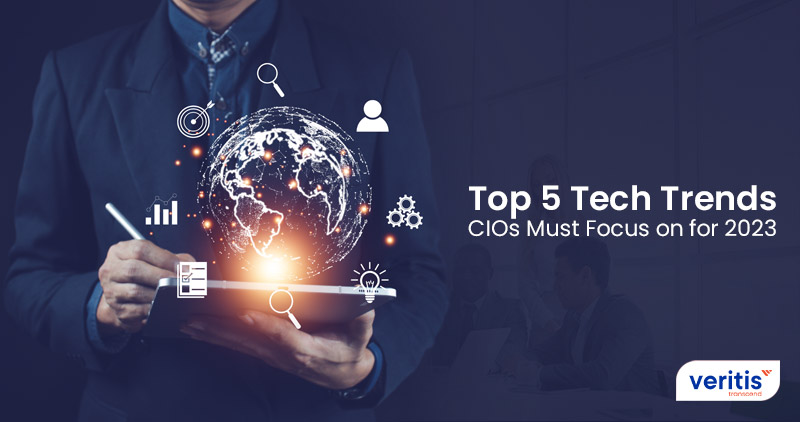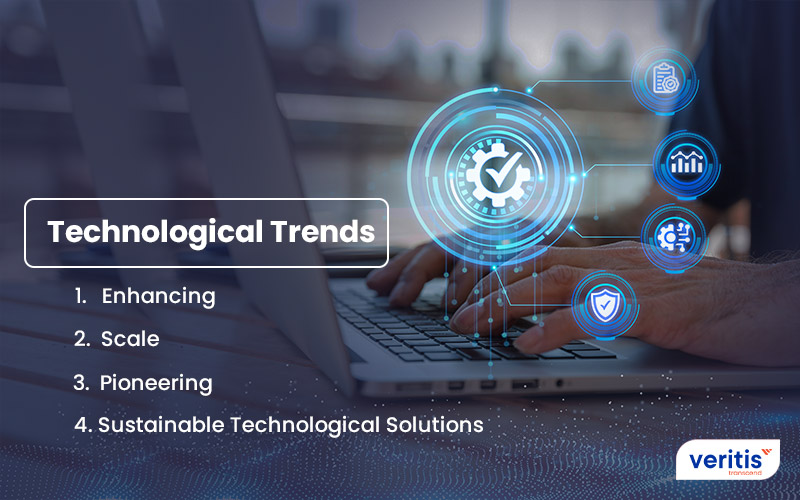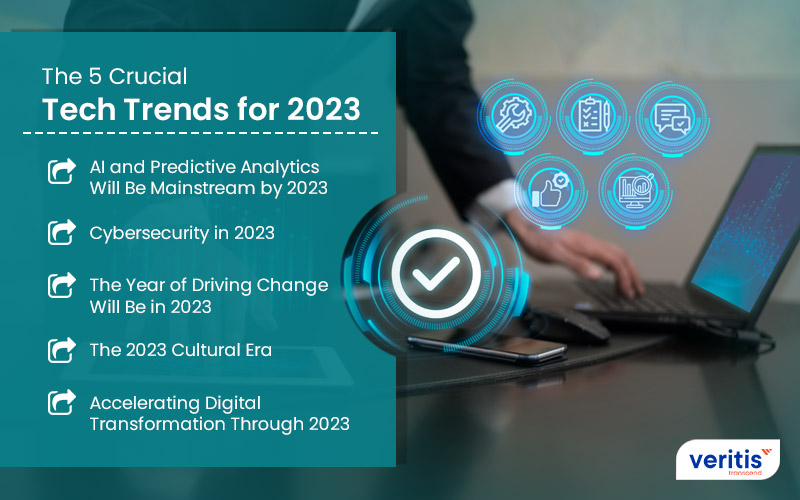
CIOs (Chief Information Officers) must protect the organization, be able to effect a change and offer data insights to their businesses if they wanted to succeed in 2023. Keeping up with predictions and future trends is part of the journey which you should continue with.
As businesses worldwide continue to deal with the pandemic’s aftermath and navigate unpredictable economic conditions, they are making significant adjustments to their corporate processes and service delivery.
The potential for cost-cutting forces businesses to focus more intently on their bottom line and on providing practical value alongside efforts to expand their consumer base. As a result, in 2023, CIOs will have to strike a balance between two potentially opposing needs: enabling new services to achieve a competitive advantage and decreasing costs.
Many businesses have succeeded by capitalizing on the tech trends and moving more critical business applications to the cloud. In addition, moving systems to the cloud gives them insights into apprehensive economic conditions.
Business leaders and technologists can use this list to evaluate the future effects of these technological developments on your particular strategy, such as increasing revenue, advancing digital, maximizing value from data, or defending and enhancing your brand.
These tech trends are either a risk or an opportunity for your company, and this blog will assist you in developing a technological roadmap to impact various strategic goals.
Which Corporate Priorities Will the Upcoming Tech Trends Assist in Addressing?

Within the next three years, we anticipate that the trend technologies for 2023 will have an impact on business strategies by enabling companies to meet four crucial priorities:
1) Enhancing
These developments enhance the data-driven decision-making process, increase the stability of IT systems, and protect the integrity and worth of operational artificial intelligence (AI) systems.
A) AI TRiSM (AI Trust, Risk, and Security Management)
AI TRiSM enables data protection, governance, trustworthiness, fairness, dependability, and robustness in AI models. It incorporates techniques for interpreting AI outcomes, quickly deploying new models, actively controlling AI security, and protecting privacy and ethical concerns.
B) Digital Immune System
With several software engineering risk-reduction techniques, the digital immune system improves the client experience. It generates robust systems that reduce operational and security risks through observability, automation, and revolutionary design and testing.
C) Application of Observability
Applied Observability uses AI to assess and recommend actions that rely on data that a company emits, enabling that business to make quicker and more accurate decisions in the future. In addition, it can be used methodically to improve business operations in real time and lower response latency.
2) Scale
These technological developments speed up vertical offerings, quicken the pace of product delivery, and enable global connectivity.
A) Realization of Wireless Value
Wireless-value realization includes everything related to the delivery of wireless network services, such as conventional end-user computing, support for edge devices, digital tagging solutions, and others. These networks offer much more than just connectivity; they also give systems a direct way to harvest network energy, location, and other real-time information and analytics-based insight.
B) Industry Cloud Platforms
Industry Cloud Platforms involve SaaS, PaaS, and IaaS with specialized, sector-specific capabilities that businesses can employ to adjust to the constant stream of upheavals more quickly in their sector.
C) Platform Engineering
Platform Engineering offers a curated selection of tools, abilities, and processes that are packaged for developers and end users to consume quickly. As a result, it will lessen the workload on development teams and boost end users’ productivity.
3) Pioneering
These developments emphasize making it possible to modify business models, rethinking how consumers and employees are engaged, and quickening the process of developing new virtual market entry tactics.
A) Metaverse
People can recreate or improve their physical activities in the metaverse. This could be accomplished by transferring or extending real-world activities into virtual ones or altering the real world. The concept was well-explored in Steven Spielberg’s Ready Player One movie, in which the actors lead a parallel life in the metaverse.
B) Super Apps
Super apps are more than simply aggregating service-based composite applications. Instead, a nifty app combines the functionality of an app, a platform, and an ecosystem into a single application, giving a platform for other people to create and distribute their mini-apps.
C) Flexible AI
Using real-time feedback, flexible AI enables model behavior to change after deployment. It continuously adapts based on runtime models and development contexts based on new data. It changes goals to respond swiftly to practical circumstances.
4) Sustainable Technological Solutions
In 2023, developing autonomous technology is the need of the hour as global demand for solutions is burgeoning daily. As the world cares about ecological imbalance, there is an increased focus on sustainable solutions. Sustainable technology solutions are a framework of approaches that improve the energy and efficiency of IT services, enabling enterprise sustainability through tools like traceability, analytics, and emissions management software. AI also plays a vital role in achieving sustainability goals.
Investments in sustainable autonomous technological solutions have the potential to increase operational resilience, improve financial performance, and open up new growth opportunities.
Useful link: Top 9 Digital Transformation Trends in 2023
The 5 Crucial Tech Trends for 2023

1) AI and Predictive Analytics Will Be Mainstream by 2023
As businesses grow increasingly data-driven, trend technologies in these two related professions will be among the most significant. CIOs can leverage their expertise in change management to assist their colleagues in comprehending data-driven culture and how it affects decision-making.
In 2023, more IT teams will concentrate on giving the entire workforce access to data and valuable insights. Artificial intelligence (AI) will process the massive amounts of data each firm produces; external data sources will be used to acquire even more insight, and data governance will become a top responsibility for more organizations.
Artificial intelligence will start to exist in enterprises in 2023. With its simple drag-and-drop interfaces, no-code AI allows any company to use its capacity to develop more intelligent goods and services.
This trend is already palpable in the retail sector. For instance, Stitch Fix uses AI-enabled algorithms to make clothing recommendations to its clients that fit their sizes and preferences. Major new emerging technologies for 2023 will be contactless, autonomous shopping and delivery. AI will simplify the purchasing and delivery of goods and services for consumers.
Additionally, AI will improve almost all jobs and corporate processes across all sectors. For instance, as more shops implement AI to manage and automate the intricate inventory management procedures that take place behind the scenes, convenience trends like buy-online-pickup-at-curbside (BOPAC), buy-online-pickup-in-store (BOPIS), and buy-online-return-in-store (BORIS) will become the norm.
Moreover, AI will drive the most recent autonomous delivery efforts that retailers are testing and implementing. As a result, more retail employees will need to get used to dealing with robots in order to do their jobs.
Enterprises can use adaptive AI, which combines real-time feedback and flexible learning algorithms to develop a sense of the business and give a response to changing environments if issues with trust, production, and generation of individualized analysis have been resolved.
In addition to giving businesses the option to continuously customize the algorithms’ output for the user, which offers specialized, individualized offerings to users, it also allows them to develop and access new data for testing in these environments.
2) Cybersecurity in 2023
Due to the continued rise in ransomware attacks in 2023, more firms are anticipated to use robust security measures, including continuous penetration testing as a service. Most of these attacks use known flaws that still need to be fixed. Organizations will be able to identify problems almost immediately and get assurance that they have been fixed thanks to advancements in pen testing.
According to Gartner, cybersecurity mesh practices will dominate the field of information security. Strategic technology consulting strongly emphasizes protecting a network through numerous security checkpoints.
Technologists play a more active part in product development as future technologies are integrated more deeply into products (such as IoT devices).
The predicted areas with the biggest cyber investment include managed security services (30%), network security (22%), mobile security (9%), and online and email security (8%).
These new emerging technologies in 2023 include some of the following:
- Multiple identities and protocols for access control
- Establishing a pool for staff matching
- Widespread use of zero-trust security networks
- Rapid implementation of security features
- Included more tech-savvy individuals on executive boards
- Security testing standards and higher compliance for numerous products and services
- Increased cooperation between information security firms to establish standardized security features
Vistage members must keep investing to ensure that strategic technology consulting supports their company’s development and serves as the cornerstone of competitive advantage.
Useful link: Cloud Computing Trends Which Shall Dominate 2023
3) The Year of Driving Change Will Be in 2023
CIOs may be more aware than their counterparts that change is occurring at an ever-increasing rate. They understand that they must act as a catalyst for change if they want the company to prosper in the digital age.
CIOs are anticipated to start creating a leadership team in their firms in 2023 and beyond. Businesses are starting to realize digital skills’ importance, and IT will take the lead in educating and mentoring their peers. In addition, new future technologies like virtual reality and augmented reality will execute to support ongoing learning and feedback.
Consider thinking back on your vision to establish your team of leaders.
- What awaits us in future trends?
- What will hard and soft talents be required in your organization to achieve that vision?
- Who today possesses those abilities?
- Who can pick those up?
- Should someone from outside the company be hired to fill the gap?
Then, you can create a roadmap to ensure you and your team have the abilities required to realize your goal.
4) The 2023 Cultural Era
CIOs are becoming aware of the need to participate in establishing the culture within their teams and the larger enterprise. In addition, as companies cope with the new realities of remote work and hybrid work arrangements, culture has become increasingly important.
More than just a paycheck, employees expect value from their jobs. They seek a sense of direction and significance in their work. They yearn for a sense of belonging (even when highly distributed). More CIOs will develop culture plans in 2023 to develop their firm’s required culture. These plans will resemble project plans. They might benefit from the new strategic technology consulting that the metaverse is producing.
5) Accelerating Digital Transformation Through 2023
Digital transformation is becoming a reality for many firms rather than just a marketing gimmick. CIOs and digital leaders have understood it is not a one-time project. It is a way of thinking.
Driving change and fostering culture came in higher on the list, demonstrating that CIOs know the need to instill a digital transformation attitude across their organizations. CIOs can apply their familiarity with agile processes across their entire company. We will use future technologies extensively as we build an intelligent enterprise.
Useful link: Guide to Digital Transformation Technologies and Their Business Impact
Conclusion
CIOs and other IT executives must consider the future and what will happen in 2023. They must be prepared for the tech trends the analyst firms have highlighted. The day-to-day operations of their company and department must be managed at the same time.
To navigate 2023, CIOs will need to improve their ability to see the future of their enterprises while still meeting their immediate demands. In addition, organizations will need to adapt to the digital economy and become data-driven. The CIO manages change, protects the company’s digital assets, and develops a culture that engages customers and staff.
Veritis, the Stevie Awards winner, has offered guidance and innovative solutions to start-ups and Fortune 500 companies. Reach out to us with your specific needs, and we’ll create solutions that are suited to your requirements and assist you in reaching your full potential.
Got Questions? Schedule A Call
Additional Resources: